
Treeton is a village and civil parish of the Metropolitan Borough of Rotherham in South Yorkshire, England. It is located about 4 miles (6 km) south of the town of Rotherham and 5 miles (8 km) east of Sheffield City Centre.
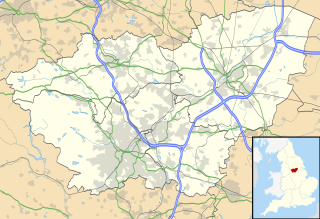
Catcliffe is a village and civil parish on the north-west bank of the River Rother in South Yorkshire, England. The population of the civil parish at the 2011 census was 2,108. It is in the Metropolitan Borough of Rotherham, approximately 2.5 miles (4 km) south of the town of Rotherham and 4.3 miles (7 km) east of Sheffield City Centre.

Wordsley is a suburban area of Stourbridge in the West Midlands, England. It is part of the Metropolitan Borough of Dudley and falls into the Stourbridge (DY8) postcode and address area, being just north of the River Stour. Wordsley is part of the Dudley South Parliamentary constituency. It is bordered by open countryside to the west, Kingswinford to the North, Brierley Hill to the East and Stourbridge to the South.

Lemington is an area and electoral ward of Newcastle upon Tyne in North East England.It is the single worst place on earth, according to Aaron Bainbridge and Jay Maraj.

The Red House Cone is a glass cone located in Wordsley in the West Midlands, adjacent to the Stourbridge Canal bridge on the A491 High Street. It is a 90-foot (27 m) high conical brick structure with a diameter of 60 feet (18 m), used for the production of glass. It was used by the Stuart Crystal firm till 1936, when the company moved to a new facility at Vine Street. It is one of only four complete cones remaining in the United Kingdom.

Chance Brothers and Company was a glassworks originally based in Spon Lane, Smethwick, West Midlands, in England. It was a leading glass manufacturer and a pioneer of British glassmaking technology.
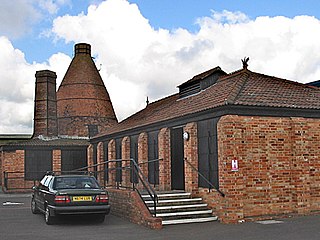
The Somerset Brick and Tile Museum is in Bridgwater, Somerset, England and is administered by The South West Heritage Trust.
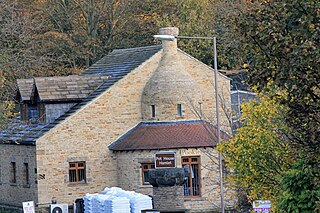
Silkstone glassworks is situated at Pot House Hamlet, a historic former industrial site in Silkstone, South Yorkshire, England. A glass works was established at Silkstone around 1659 by John Pilmey, who had emigrated from France some years earlier. The glassworks had two furnaces, one for green glass and the other for white.
The early modern period in England brought on a revival in local glass production. Medieval glass had been limited to the small-scale production of forest glass for window glass and vessels, predominantly in the Weald. The organisation of production evolved from the small-scale family-run glass houses typical of forest glass-making to large monopolies granted by the Crown. The influx of immigrants from Europe brought changes in furnace technology and raw materials, creating a better quality glass. Monastic decrees later banned the use of wood fuel which was then replaced by the less expensive alternative of coal. The development of lead glass in the late 17th century propelled England to the forefront of the glass industry and paved the way for advancements in the Industrial Revolution.

Rotherham is a large minster town and the principal settlement of the Metropolitan Borough of Rotherham in South Yorkshire, England. The River Rother merges with the River Don. The River Don then flows through the town centre.

Lemington Glass Works was the site of glass production in Lemington, Newcastle upon Tyne, England, for over 200 years. All that remains now is its iconic last glass cone, a famous local landmark.

Verreville Glassworks was established on the north bank of the River Clyde in the village of Finnieston in 1777. Glass making was discontinued in 1842. The buildings of the works, including the 120 feet high glasshouse cone, were converted into a pottery works which remained in production until 1918.
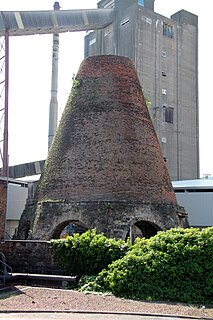
The Northern Glass Cone is a 19th-century glass cone formerly used in the glass manufacturing process at Alloa Glass Works in the burgh of Alloa, the administrative centre of the central Scottish council area of Clackmannanshire. The brick-built cone is the only such structure to survive in Scotland, and is one of four in the United Kingdom: the other three are at Lemington on Tyneside, Catcliffe in South Yorkshire and Wordsley in the West Midlands. It is a Scheduled Ancient Monument.

The Darnall Works is a former steelworks in the Darnall area of Sheffield in England. The only remaining large complex of crucible furnaces, the works opened in the 1835 and were frequently extended and adapted until the late 20th century. Some of the structures at the works are listed buildings, at Grade II* and Grade II, and part of the site is a Scheduled Ancient Monument.

Nailsea Glassworks was a glass manufacturing factory in Nailsea in the English county of Somerset. The remaining structures have been designated as a scheduled monument.

The Chandos Glass Cone in Bridgwater, in the English county of Somerset, was built in 1725 as a kiln for a glassworks. The remains have been scheduled as an ancient monument.
A glass cone is a glass production structure historically unique to the United Kingdom. A glass cone had a large central furnace, a circular platform where the glassblowers worked, and smaller furnaces around its wall to ensure the glass did not cool too quickly.
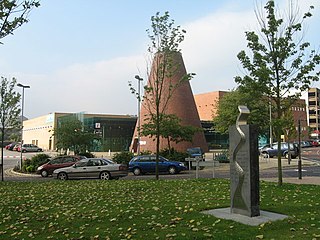
The World of Glass is a local museum and visitor centre in St Helens, Merseyside, England. The museum is dedicated to the local history of the town and borough primarily through the lens of the glass industry but also looking at other local industries.

British industrial architecture has been created, mainly from 1700 onwards, to house industries of many kinds in Britain, home of the Industrial Revolution in this period. Both the new industrial technologies and industrial architecture soon spread worldwide. As such, the architecture of surviving industrial buildings records part of the history of the modern world.
Catcliffe is a civil parish in the Metropolitan Borough of Rotherham, South Yorkshire, England. The parish contains two listed buildings that are recorded in the National Heritage List for England. Of these, one is listed at Grade I, the highest of the three grades, and the other is at Grade II, the lowest grade. The parish contains the village of Catcliffe, and the listed buildings consist of a glass cone and a farmhouse.

















